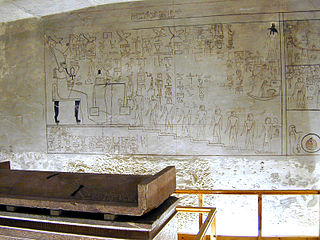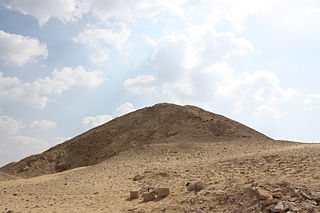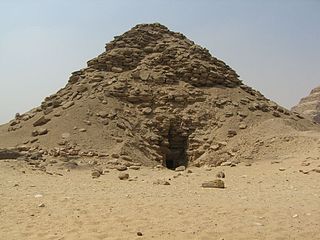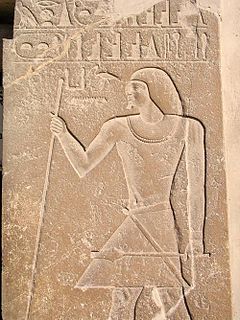Related Research Articles

The Pyramid of Khafre or of Chephren is the second-tallest and second-largest of the 3 Ancient Egyptian Pyramids of Giza and the tomb of the Fourth-Dynasty pharaoh Khafre (Chefren), who ruled c. 2558−2532 BC.

Tomb KV57 is the royal tomb of Horemheb, the last pharaoh of the Eighteenth Dynasty and is located in the Valley of the Kings, Egypt.

The Pyramid of Teti is a smooth-sided pyramid situated in the pyramid field at Saqqara in Egypt. It is the second known pyramid containing pyramid texts. Excavations have revealed a satellite pyramid, two pyramids of queens accompanied by cult structures, and a funerary temple. The pyramid was opened by Gaston Maspero in 1882 and the complex explored during several campaigns ranging from 1907 to 1965. It was originally called Teti's Places Are Enduring. The preservation above ground is very poor, and it now resembles a small hill. Below ground the chambers and corridors are very well preserved.

The Tomb of Perneb is a mastaba-style tomb from ancient Egypt, built during the reigns of Djedkare Isesi and Unas, in the necropolis of Saqqara, north of Pharaoh Djoser's Step Pyramid and about 30 kilometers south of Giza, Egypt. It was the tomb of Perneb, and from the size and placement of the tomb he might have been a court official or royal family member.

The Pyramid of Khendjer was a pyramid built for the burial of the 13th dynasty pharaoh Khendjer, who ruled Egypt c. 1760 BC during the Second Intermediate Period. The pyramid, which is part of larger complex comprising a mortuary temple, a chapel, two enclosure walls and a subsidiary pyramid, originally stood around 37 m (121 ft) high and is now completely ruined. The pyramidion was discovered during excavations under the direction of Gustave Jéquier in 1929, indicating that the pyramid was finished during Khendjer's lifetime. It is the only pyramid known to have been completed during the 13th Dynasty.

The Black Pyramid was built by King Amenemhat III during the Middle Kingdom of Egypt. It is one of the five remaining pyramids of the original eleven pyramids at Dahshur in Egypt. Originally named Amenemhet is Mighty, the pyramid earned the name Black Pyramid for its dark, decaying appearance as a rubble mound. The Black Pyramid was the first to house both the deceased pharaoh and his queens. Jacques de Morgan, on a French mission, began the excavation on the pyramids at Dahshur in 1892. The German Archaeological Institute of Cairo completed excavation in 1983.

The pyramid complex of Userkaf was built c. 2490 BC for the pharaoh Userkaf, founder of the 5th Dynasty of Egypt. It is located in the pyramid field at Saqqara, on the north-east of the step pyramid of Djoser. Constructed in dressed stone with a core of rubble, the pyramid is now ruined and resembles a conical hill in the sands of Saqqara. For this reason, it is known locally as El-Haram el-Maharbish, the "Heap of Stone", and was recognized as a royal pyramid by western archaeologists in the 19th century.

The Pyramid of Djedkare Isesi is a late 25th to mid 24th century BC pyramid complex built for the Fifth Dynasty pharaoh Djedkare Isesi. The pyramid is referred to as Haram el-Shawaf by locals. It was the first pyramid to be built in South Saqqara.

Ptahshepses was the vizier and son-in-law of the Fifth Dynasty pharaoh Nyuserre Ini. As such he was one of the most distinguished members of the royal court. Ptahshepses' mastaba complex in Abusir is considered by many to be the most extensive and architecturally unique non-royal tomb of the Old Kingdom.
Nebemakhet was a king's son and a vizier during the 4th Dynasty. Nebemakhet was the son of King Khafre and Queen Meresankh III. He is shown in his mother's tomb and in his own tomb at Giza.

Khentkaus I, also referred to as Khentkawes, was a royal woman who lived in ancient Egypt during both the Fourth Dynasty and the Fifth Dynasty. She may have been a daughter of king Menkaure, the wife of both king Shepseskaf and king Userkaf, the mother of king Sahure. Some suggest that she was the regent for one of her sons. Perhaps, in her own right, she may have been the king of Upper and Lower Egypt, which aspects of her burial suggests. Her mastaba at Giza – tomb LG100 – is located very close to Menkaure's pyramid complex. This close connection may point to a family relationship. Although the relationship is not clear, the proximity of the pyramid complex of Khentkaus to that of king Menkaure has led to the conjecture that she may have been his daughter.

Kagemni was a vizier from the early part of the reign of King Teti of the Sixth Dynasty of Egypt. Kagemni's wife Nebtynubkhet Sesheshet was a King's Daughter and likely the daughter of Teti.
Ankhmare was an ancient Egyptian prince and vizier of the 4th Dynasty. His titles include king's eldest son of his body, as well as chief justice and vizier. Ankhmare was a son of Pharaoh Khafre and was named after the god Ra.
Hemetre (Hemetra) was an ancient Egyptian royal woman of the Fourth Dynasty. Hemetre may have been a daughter or granddaughter of Khafre. She did not hold the title king's wife and may have even married a non-royal. She is mainly known from her tomb, which is located in the central field of Giza. Her name honors the god Ra.
Rekhetre was an ancient Egyptian queen from the late 4th Dynasty or early 5th Dynasty. She was a daughter of Pharaoh Khafre. Her husband is never mentioned, but Rekhetre would have been the wife of one of Khafre's successors, possibly Menkaure.
Khentkaus III, often called Khentakawess III by news media, was an ancient Egyptian queen who lived during the Fifth Dynasty, around 2450 BC.

The Pyramid of Senusret III is an ancient Egyptian pyramid located at Dahshur and built for pharaoh Senusret III of the 12th Dynasty.

The Pyramid of Khentkaus II is a queen's pyramid in the necropolis of Abousir in Egypt, which was built during the Fifth dynasty of Ancient Egypt. It is attributed to the queen Khentkaus II, who may have ruled Egypt as a reigning queen after the death of her husband Neferirkare Kakai. The pyramid is now a heavily damaged ruin, which only stands 4 metres high.

The Pyramid of Senusret II,, is the pyramid complex constructed for the pharaoh Senusret II in the Twelfth Dynasty.

The Pyramid complex of Khentkaus I or Step tomb of Khentkaus I is a Fourth Dynasty two-stepped tomb built for the Queen Mother Khentkaus I in Giza. The tomb, built in two phases coinciding with its two steps, was originally known as the fourth pyramid of Giza. In the first phase, a nearly square block of bedrock, around which the stone had been quarried for the Giza pyramids, was utilized to construct her tomb and encased with fine white Tura limestone. In the second phase, most likely in the Fifth Dynasty, her tomb was enlarged with a large limestone structure built on top of the bedrock block. The Egyptologist Miroslav Verner suggests that this may have been intended to convert her tomb into a pyramid, but was abandoned as a result of stability concerns. South-west of the tomb was a long boat pit, which housed the Night boat of Re. A companion day boat has not been found. A chapel was built into the tomb superstructure, with a large granite entrance bearing the queen's name and titles. One of her titles was of particular interest because it had not previously been known.
References
- ↑ Dodson, Aidan and Hilton, Dyan. The Complete Royal Families of Ancient Egypt. Thames & Hudson. 2004. ISBN 0-500-05128-3
- ↑ Porter, Bertha and Moss, Rosalind, Topographical Bibliography of Ancient Egyptian Hieroglyphic Texts, Statues, Reliefs and Paintings Volume III: Memphis, Part I Abu Rawash to Abusir. 2nd edition (revised and augmented by Dr Jaromir Malek, 1974. Retrieved from gizapyramids.org Archived 2008-10-11 at the Wayback Machine
- 1 2 3 Hassan, Selim. Excavations at Gîza 7: 1935-1936. The Mastabas of the Seventh Season and their Description. Cairo: Government Press, 1953.